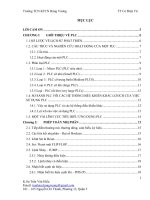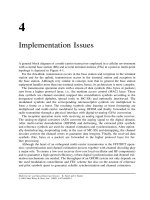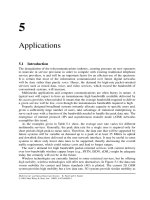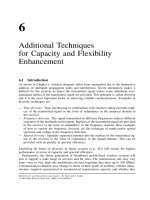MC và các hệ thống phổ Bá P6
Bạn đang xem bản rút gọn của tài liệu. Xem và tải ngay bản đầy đủ của tài liệu tại đây (491.56 KB, 29 trang )
6
Additional Techniques
for Capacity and Flexibility
Enhancement
6.1 Introduction
As shown in Chapter 1, wireless channels suffer from attenuation due to the destructive
addition of multipath propagation paths and interference. Severe attenuation makes it
difficult for the receiver to detect the transmitted signal unless some additional, less-
attenuated replica of the transmitted signal are provided. This principle is called diversity
and it is the most important factor in achieving reliable communications. Examples of
diversity techniques are:
— Time diversity: Time interleaving in combination with channel coding provides repli-
cas of the transmitted signal in the form of redundancy in the temporal domain to
the receiver.
— Frequency diversity: The signal transmitted on different frequencies induces different
structures in the multipath environment. Replicas of the transmitted signal are provided
to the receiver in the form of redundancy in the frequency domain. Best examples
of how to exploit the frequency diversity are the technique of multi-carrier spread
spectrum and coding in the frequency direction.
— Spatial diversity: Spatially separated antennas provide replicas of the transmitted sig-
nal to the receiver in the form of redundancy in the spatial domain. This can be
provided with no penalty in spectral efficiency.
Exploiting all forms of diversity in future systems (e.g., 4G) will ensure the highest
performance in terms of capacity and spectral efficiency.
Furthermore, the future generation of broadband mobile/fixed wireless systems will
aim to support a wide range of services and bit rates. The transmission rate may vary
from voice to very high rate multimedia services requiring data rates up to 100 Mbit/s.
Communication channels may change in terms of their grade of mobility, cellular infras-
tructure, required symmetrical or asymmetrical transmission capacity, and whether they
Multi-Carrier and Spread Spectrum Systems K. Fazel and S. Kaiser
2003 John Wiley & Sons, Ltd ISBN: 0-470-84899-5
234 Additional Techniques for Capacity and Flexibility Enhancement
are indoor or outdoor. Hence, air interfaces with the highest flexibility are demanded
in order to maximize the area spectrum efficiency in a variety of communication envi-
ronments. The adaptation and integration of existing and new systems to emerging new
standards would be feasible if both the receiver and the transmitter are reconfigurable
using software-defined radio (SDR).
The aim of this last chapter is to look at new antenna diversity techniques (e.g., space
time coding (STC), space frequency coding (SFC) and at the concept of software-defined
radio (SDR) which will all play a major role in the realization of 4G.
6.2 General Principle of Multiple Antenna Diversity
In conventional wireless communications, spectral and power efficiency is achieved by
exploiting time and frequency diversity techniques. However, the spatial dimension so far
only exploited for cell sectorization will play a much more important role in future wireless
communication systems. In the past most of the work has concentrated on the design of
intelligent antennas, applied for space division multiple access (SDMA). In the meantime,
more general techniques have been introduced where arbitrary antenna configurations at
the transmit and receive sides are considered.
If we consider M transmit antennas and L receive antennas, the overall system channel
defines the so-called multiple input/multiple output (MIMO) channel (see Figure 6-1). If
the MIMO channel is assumed to be linear and time-invariant during one symbol duration,
the channel impulse response h(t) can be written as
h(t) =
h
0,0
(t) ··· h
0,L−1
(t)
.
.
.
.
.
.
.
.
.
h
M−1,0
(t) ··· h
M−1,L−1
(t)
(6.1)
where h
m,l
(t) represents the impulse response of the channel between the transmit (Tx)
antenna m and the receive (Rx) antenna l.
From the above general model, two possibilities exist: i) case M = 1, resulting in a
single input/multiple output (SIMO) channel and ii) case L = 1, resulting in a multiple
input/single output (MISO) channel. In the case of SIMO, conventional receiver diversity
M Tx antennas
L
Rx antennas
.
.
.
.
.
.
Figure 6-1 MIMO channel
General Principle of Multiple Antenna Diversity 235
techniques such as MRC can be realized, which can improve power efficiency, especially
if the channels between the Tx and the Rx antennas are independently faded paths (e.g.,
Rayleigh distributed), where the multipath diversity order is identical to the number of
receiver antennas [15].
With diversity techniques, a frequency- or time-selective channel tends to become an
AWGN channel. This improves the power efficiency. However, there are two ways to
increase the spectral efficiency. The first one, which is the trivial way, is to increase the
symbol alphabet size and the second one is to transmit different symbols in parallel in
space by using the MIMO properties.
The capacity of MIMO channels for an uncoded system in flat fading channels with
perfect channel knowledge at the receiver is calculated by Foschini [11] as
C = log
2
det
I
L
+
E
s
/N
o
M
h(t)h
∗T
(t)
,(6.2)
where “det” means determinant, I
L
is an L × L identity matrix, and (·)
∗T
means the
conjugate complex of the transpose matrix. Note that this formula is based on the Shannon
capacity calculation for a simple AWGN channel.
Two approaches exist to exploit the capacity in MIMO channels. The information the-
ory shows that with M transmit antennas and L = M receive antennas, M independent
data streams can be simultaneously transmitted, hence, reaching the channel capacity. As
an example, the BLAST (Bell-Labs Layered Space Time) architecture can be referred
to [11][20]. Another approach is to use a MISO scheme to obtain diversity, where in
this case sophisticated techniques such as space–time coding (STC) can be realized.
All transmit signals occupy the same bandwidth, but they are constructed such that the
receiver can exploit spatial diversity, as in the Alamouti scheme [1]. The main advan-
tage of STCs especially for mobile communications is that they do not require multiple
receive antennas.
6.2.1 BLAST Architecture
The basic concept of the BLAST architecture is to exploit channel capacity by increasing
the data rate through simultaneous transmission of independent data streams over M
transmit antennas. In this architecture, the number of receive antennas should at least be
equal to the number of transmit antennas L
M (see Figure 6-1).
For m-array modulation, the receiver has to choose the most likely out of m
M
pos-
sible signals in each symbol time interval. Therefore, the receiver complexity grows
exponentially with the number of modulation constellation points and the number of
transmit antennas. Consequently, suboptimum detection techniques such as those pro-
posed in BLAST can be applied. Here, in each step only the signal transmitted from a
single antenna is detected, whereas the transmitted signals from the other antennas are
canceled using the previously detected signals or suppressed by means of zero-forcing or
MMSE equalization.
Two basic variants of BLAST are proposed [11][20]: D-BLAST (diagonal BLAST) and
V-BLAST (vertical BLAST). The only difference is that in V-BLAST transmit antenna
m corresponds all the time to the transmitted data stream m, where in D-BLAST the
assignment of the antenna to the transmitted data stream is hopped periodically. If the
236 Additional Techniques for Capacity and Flexibility Enhancement
Modulation
Modulation
Modulation
Detection
Detection
Detection
Interference estimation
−
−
−
Stream 0
Stream M − 1
Stream M − 1
Stream 1
Stream 0
Stream 1
Transmitter
Receiver (L = M)
.
.
.
.
.
.
Figure 6-2 V-BLAST transceiver
channel does not vary during transmission, in V-BLAST, the different data streams may
suffer from asymmetrical performance. Furthermore, in general the BLAST performance
is limited due to the error propagation issued by the multistage decoding process.
As it is illustrated in Figure 6-2, for detection of data stream 0, the signals transmitted
from all other antennas are estimated and suppressed from the received signal of the data
stream 0. In [2][3] an iterative decoding process for the BLAST architecture is proposed,
which outperforms the classical approach.
However, the main disadvantages of the BLAST architecture for mobile communi-
cations is the need of high numbers of receive antennas, which is not practical in a
small mobile terminal. Furthermore, high system complexity may prohibit the large-scale
implementation of such a scheme.
6.2.2 Space–Time Coding
An alternative approach is to obtain transmit diversity with M transmit antennas, where the
number of received antennas is not necessarily equal to the number of transmit antennas.
Even with one receive antenna the system should work. This approach is more suitable
for mobile communications.
The basic philosophy with STC is different from the BLAST architecture. Instead
of transmitting independent data streams, the same data stream is transmitted in an
appropriate manner over all antennas. This could be, for instance, a downlink mobile
communication, where in the base station M transmit antennas are used while in the
terminal station only one or few antennas might be applied.
The principle of STC is illustrated in Figure 6-3. The basic idea is to provide through
coding constructive superposition of the signals transmitted from different antennas.
Constructive combining can be achieved for instance by modulation diversity, where
General Principle of Multiple Antenna Diversity 237
Single
stream
Space–
time
coding
(STC)
Space–
time
decoding
Single
stream
Optional
Figure 6-3 General principle of space–time coding (STC)
orthogonal pulses are used in different transmit antennas. The receiver uses the respective
matched filters, where the contributions of all transmit antennas can be separated and
combined with MRC.
The simplest form of modulation diversity is delay diversity, a special form of
space–time trellis codes. The other alternative of STC is space–time block codes. Both
spatial coding schemes are described in the following.
6.2.2.1 Space–Time Trellis Codes (STTC)
The simplest form of STTCs is the delay diversity technique (see Figure 6-4). The idea is
to transmit the same symbol with a delay of iT
s
from transmit antenna i = 0,...,M − 1.
The delay diversity can be viewed as a rate 1/M repetition code. The detector could be
a standard equalizer. Replacing the repetition code by a more powerful code, additional
coding gain on top of the diversity advantage can be obtained [16]. However, there is no
general rule how to obtain good space–time trellis codes for arbitrary numbers of transmit
antennas and modulation methods. Powerful STTCs are given in [18] and obtained from
an exhaustive search. However, the problem of STTCs is that the detection complexity
measured in the number of states grows exponentially with m
M
.
In Figure 6-5, an example of a STTC for two transmit antennas M = 2incaseof
QPSK m = 2 is given. This code has four states with spectral efficiency of 2 bit/s/Hz.
Assuming ideal channel estimation, the decoding of this code at the receive antenna j
can be performed by minimizing the following metric:
D =
L−1
j=0
r
j
−
M−1
i=0
h
i,j
x
i
2
,(6.3)
where r
j
is the received signal at receive antenna j and x
i
is the branch metric in
the transition of the encoder trellis. Here, the Viterbi algorithm can be used to choose
the best path with the lowest accumulated metric. The results in [18] show the coding
advantages obtained by increasing the number of states as the number of received antennas
is increased.
238 Additional Techniques for Capacity and Flexibility Enhancement
Single
stream
Repetition
code rate
1/M
Detection
Single
stream
Optional
T
s
(M − 1)T
s
Figure 6-4 Space–time trellis code with delay diversity technique
1
2
3
0
State 0
State 1
State 2
State 3
State 0
State 1
State 2
State 3
00
01
02
03
10
11
12
13
20
21
22
23
30 31
32
33
Figure 6-5 Space–time trellis code with four states
6.2.2.2 Space–Time Block Codes (STBC)
A simple transmit diversity scheme for two transmit antennas using STBCs was intro-
duced by Alamouti in [1] and generalized to an arbitrary number of antennas by Tarokh
et al. [17]. Basically, STBCs are designed as pure diversity schemes and provide no addi-
tional coding gain as with STTCs. In the simplest Alamouti scheme with M = 2 antennas,
the transmitted symbols x
i
are mapped to the transmit antenna with the mapping
B =
x
0
x
1
−x
∗
1
x
∗
0
, (6.4)
where the row corresponds to the time index and the column to the transmit antenna index.
In the first symbol time interval x
0
is transmitted from antenna 0 and x
1
is transmitted from
General Principle of Multiple Antenna Diversity 239
antenna 1 simultaneously, where in the second symbol time interval antenna 0 transmits
−x
∗
1
and simultaneously antenna 1 transmits x
∗
0
.
The coding rate of this STBCs is one, meaning that no bandwidth expansion will
take place (see Figure 6-6). Due to the orthogonality of the space–time block codes, the
symbols can be separated at the receiver by a simple linear combining (see Figure 6-7).
The spatial diversity combining with block codes applied for multi-carrier transmission
is described in more detail in Section 6.3.4.1.
6.2.3 Achievable Capacity
For STBCs of rate R the channel capacity is given by [2]
C = R log
2
1 +
E
s
/N
o
M
M−1
i=0
L−1
j=0
|h
i,j
|
2
.(6.5)
For R = 1andL = 1, this is equivalent to the channel capacity of a MISO scheme.
However, for L>1, the capacity curve is only shifted, but the asymptotic slope is not
Single
stream
Space–time
mapper, B
(STBC)
Detection
Single
stream
Optional
Figure 6-6 Space–time block code transceiver
At time i
At time i + 1
x
0
x
1
x
1
x
0
−1
h
00
h
10
h
10
h
00
T
s
Noise
0
Noise
1
−h
00
T
s
h
10
y
0
y
1
Maximum ratio combining
0
1
1
0
h
10
*
h
00
*
Figure 6-7 Principle of space–time block coding
240 Additional Techniques for Capacity and Flexibility Enhancement
increased, therefore, the MIMO capacity will not be achieved [3]. This also corresponds
to results for STTCs.
From an information theoretical point of view it can be concluded that STCs should be
used in systems with L = 1 receive antennas. If multiple receive antennas are available,
the data rate can be increased by transmitting independent data from different antennas
as in the BLAST architecture.
6.3 Diversity Techniques for Multi-Carrier Transmission
6.3.1 Transmit Diversity
Several techniques to achieve spatial transmit diversity in OFDM systems are discussed
in this section. The number of used transmit antennas is M. OFDM is realized by an IFFT
and the OFDM blocks shown in the following figures also include a frequency interleaver
and a guard interval insertion/removal. It is important to note that the total transmit power
is the sum of the transmit power
m
of each antenna, i.e.,
=
M−1
m=0
m
.(6.6)
In the case of equal transmit power per antenna, the power per antenna is
m
=
M
.(6.7)
6.3.1.1 Delay Diversity
As discussed before, the principle of delay diversity (DD) is to artificially increase the
frequency selectivity of the mobile radio channel by introducing additional constructive
delayed signals. Delay diversity can be considered a simple form of STTC. Increased
frequency selectivity can enable a better exploitation of diversity which results in an
improved system performance. With delay diversity, the multi-carrier modulated signal
itself is identical on all M transmit antennas and differs only in an antenna-specific delay
δ
m
,m= 1,...,M − 1 [14]. The block diagram of an OFDM system with spatial transmit
diversity applying delay diversity is shown in Figure 6-8.
OFDM
d
1
d
M − 1
0
1
M − 1
IOFDM
transmitter
receiver
Figure 6-8 Delay diversity
Diversity Techniques for Multi-Carrier Transmission 241
In order to achieve frequency selective fading within the transmission bandwidth B,
the delay has to fulfill the condition
δ
m
1
B
.(6.8)
To increase the frequency diversity by multiple transmit antennas, the delay of the different
antennas should be chosen as
δ
m
km
B
,k
1,(6.9)
where k is a constant factor introduced for the system design which has to be chosen
large enough (k
1) in order to guarantee a diversity gain. A factor of k = 2seemstobe
sufficient to achieve promising performance improvements in most scenarios. This result
is verified by the simulation results presented in Section 6.3.1.2.
The disadvantage of delay diversity is that the additional delays δ
m
, m = 1,...,M − 1,
increase the total delay spread at the receiver antenna and require an extension of the guard
interval duration by the maximum δ
m
, m = 1,...,M− 1, which reduces the spectral
efficiency of the system. This disadvantage can be overcome by phase diversity presented
in the next section.
6.3.1.2 Phase Diversity
Phase diversity (PD) transmits signals on M antennas with different phase shifts, where
m,n
, m = 1,...,M − 1, n = 0,...,N
c
− 1, is an antenna- and sub-carrier specific phase
offset [12][13]. The phase shift is efficiently realized by a phase rotation before OFDM,
i.e., before the IFFT. The block diagram of an OFDM system with spatial transmit diver-
sity applying phase diversity is shown in Figure 6-9.
In order to achieve frequency selective fading within the transmission bandwidth of the
N
c
sub-channels, the phase
m,n
has to fulfill the condition
m,n
2πf
n
B
2πn
N
c
(6.10)
OFDM
0
1
M − 1
IOFDM
transmitter
receiver
OFDM
OFDM
e
jΦ
1, n
n = 0...N
c
− 1
e
jΦ
M − 1, n
n = 0...N
c
− 1
Figure 6-9 Phase diversity
242 Additional Techniques for Capacity and Flexibility Enhancement
where f
n
= n/T
s
is the nth sub-carrier frequency, T
s
is the OFDM symbol duration
without guard interval and B = N
c
/T
s
. To increase the frequency diversity by multiple
transmit antennas, the phase offset of the nth sub-carrier at the mth antenna should be
chosen as
m,n
=
2πkmn
N
c
,k
1,(6.11)
where k is a constant factor introduced for the system design which has to be chosen large
enough (k
1) to guarantee a diversity gain. The constant k corresponds to k introduced
in Section 6.3.1.1. Since no delay of the signals at the transmit antennas occurs with phase
diversity, no extension of the guard interval is necessary compared to delay diversity.
In Figure 6-10, the SNR gain to reach a BER of 3 · 10
−4
with 2 transmit antennas
applying delay diversity and phase diversity compared to a 1 transmit antenna scheme
over the parameter k introduced in (6.9) and (6.11) is shown for OFDM and OFDM-
CDM. The results are presented for an indoor and outdoor scenario. The performance
of delay diversity and phase diversity is the same for the chosen system parameters,
since the guard interval duration exceeds the maximum delay of the channel and the
additional delay due to delay diversity. The curves show that gains of more than 5 dB in
the indoor scenario and of about 2 dB in the outdoor scenario can be achieved for k
2
and justify the selection of k = 2 as a reasonable value. It is interesting to observe that
even in an outdoor environment, which already has frequency selective fading, significant
performance improvements are achievable.
012345678
k
0
1
2
3
4
5
6
gain in dB
indoor; OFDM
indoor; OFDM-CDM
outdoor; OFDM
outdoor; OFDM-CDM
Figure 6-10 Performance gains with delay diversity and phase diversity over k; M = 2;
BER = 3 · 10
−4
Diversity Techniques for Multi-Carrier Transmission 243
OFDM
d
cyc 1
d
cyc M − 1
0
1
M − 1
IOFDM
transmitter
receiver
guard
interval
guard
interval
guard
interval
Figure 6-11 Cyclic delay diversity
An efficient implementation of phase diversity is cyclic delay diversity (CDD) [6],
which instead of M OFDM operations requires only one OFDM operation in the trans-
mitter. The signals constructed by phase diversity and by cyclic delay diversity are equal.
Signal generation with cyclic delay diversity is illustrated in Figure 6-11. With cyclic
delay diversity, δ
cycl m
denotes cyclic shifts [7]. Both phase diversity and cyclic delay
diversity are performed before guard interval insertion.
6.3.1.3 Time-Variant Phase Diversity
The spatial transmit diversity concepts presented in the previous sections introduce only
frequency diversity. Time-variant phase diversity (TPD) can additionally exploit time
diversity. It can be used to introduce time diversity or to introduce both time and frequency
diversity. The block diagram shown in Figure 6-9 is still valid, only the phase offsets
m,n
have to be replaced by the time-variant phase offsets
m,n
(t), m = 1,...,M − 1,
n = 0,...,N
c
− 1, which are given by [13]
m,n
(t) =
m,n
+ 2π tF
m
.(6.12)
The frequency shift F
m
at transmit antenna m has to be chosen such that the channel
can be considered as time-invariant during one OFDM symbol duration, but appears time-
variant over several OFDM symbols. It has to be taken into account in the system design
that the frequency shift F
m
introduces ICI which increases with increasing F
m
.
The gain in SNR to reach the BER of 3 · 10
−4
with 2 transmit antennas applying time-
variant phase diversity compared to time-invariant phase diversity with 2 transmit antennas
over the frequency shift F
1
is shown in Figure 6-12. The frequency shifts F
m
should be
less than a few percent of the sub-carrier spacing to avoid non-negligible degradations
due to ICI.
6.3.1.4 Sub-Carrier Diversity
With sub-carrier diversity (SCD), the sub-carriers used for OFDM are clustered in M
smaller blocks and each block is transmitted over a separate antenna [5]. The principle
of sub-carrier diversity is shown in Figure 6-13.
After serial-to-parallel (S/P) conversion, each OFDM block processes N
c
/M complex-
valued data symbols out of a sequence of N
c
.EachoftheM OFDM blocks maps its
N
c
/M data symbols on its exclusively assigned set of sub-carriers. The sub-carriers of









